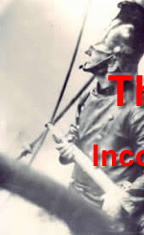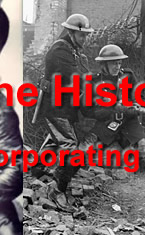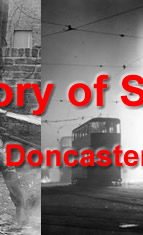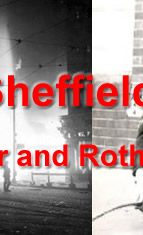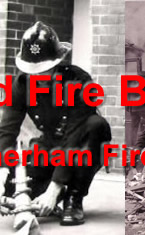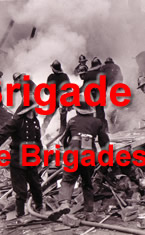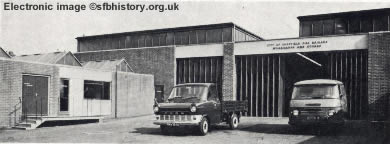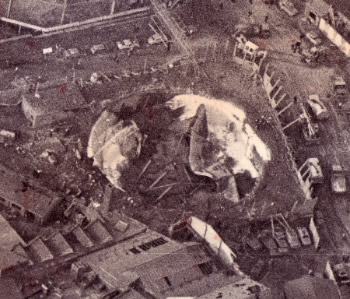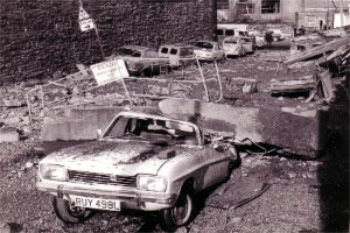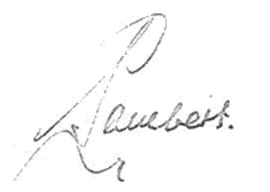
When CFO Jones died on the 11th January 1966, 55 year-old A.C.O., Lambert was selected by the City Council to replace him as Chief Fire Officer.
Stanley Lambert was born on the 7th November 1911, at 8, Marlborough Terrace, South Boulevard, Hull. He was the son of Charles Frederick Lambert, aged 31, a Police Constable, originally from High Wycombe, Buckinghamshire and Eleanor Lambert, age 29 from Doncaster, Yorkshire. In 1911 Stanley had 3 older brothers, and 2 older sisters.
In July 1934 Stanley married Irene Elizabeth Roberts, born 25th February 1910, from Hessle, East Yorkshire, at Sculcoates Hull.
In 1935 he joined Kingston-upon-Hull Fire Brigade as a Police Fireman.
In 1939 he is recorded as living with Irene at 48 King Street, Hull, and working as a Police Constable/Fireman.
As a Kingston-upon-Hull Fireman he would have served throughout the German air raids of the Hull Blitz, 7th to 9th May 1941, when the Luftwaffe changed their bombing tactics in an attempt to destroy Britain's shipping ports. The Hull Blitz killed approximately 400 people in the city, with 95% of Hull's houses left damaged. More than 300 men, women and children were buried in unmarked mass graves in Hull's Northern Cemetery.
Between 1941 to 1948 he held various appointments in the National Fire Service, and he was transferred to Sheffield in 1948, and rose to the rank of Assistant Chief Fire Officer in the reformed Sheffield Fire Brigade.
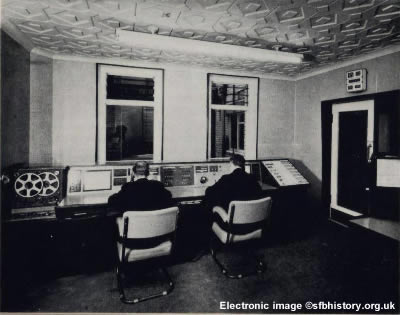 Photograph from: Sheffield Fire Brigade a Brief History |
In 1966 the Brigade Control at Division Street was modernised. A four-track, long-duration tape recorder, which was originally designed for use at Farnborough for recording incoming and outgoing aircraft messages, was adapted and installed. All four control room watches were taught how to operate the machine and cut down time in answering a call. Under the old system, an officer taking a call wrote the details down in longhand, another member of the control room staff looked over his shoulder to read the address. Then he went to find the appropriate map reference and small scale map for the men going to the fire. |
In 1967 as a result of the Sheffield Order, 1967, the Fire Station at Queen Street. Mosborough, together with the personnel and appliances was transferred from the Derbyshire County Council to Sheffield.
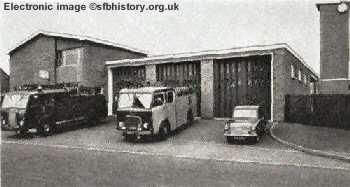 |
Fire Station No. 6, Queen Street, Mosborough |
New Workshops and Stores, that had been built on land adjoining the Fire Station at Darnall Road were opened in 1967. The Workshops are extremely well equipped to carry out all repairs to fire appliances and vehicles, and the testing of fire pumps; and a full range of items of uniform and other equipment is carried in the Stores.
|
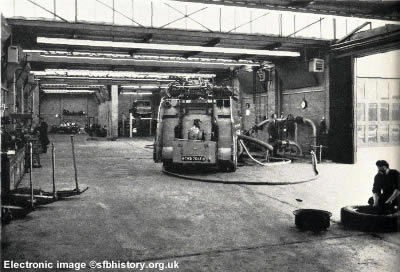 Photograph of the Workshop interior 1968 From: Sheffield Fire Brigade - A Brief History |
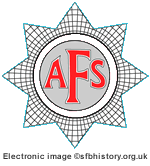 |
On the 16th January, 1968, the Prime Minister announced in the House of Commons the Government's decision to place home defence on a "care and maintenance" basis: and as a result of this decision the Auxiliary Fire Service was disbanded on the 31st March 1968, and their equipment returned to the Home Office Stores. |
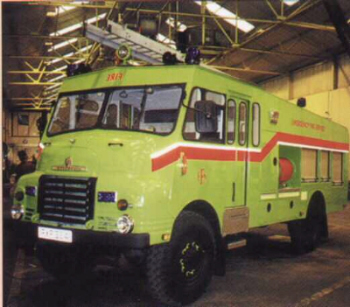 Photo of Green Goddess in 2003 after a final refurbishment, which didn't dissuade the Government from selling off the whole fleet in 2004. Photograph supplied by: Ted Mullins |
The Bedford emergency pumps (EPs) nicknamed later as the "Green Goddess" joined the vast majority of the the original Home Office fleet in already in storage where they would remained for many years. The storage depots contained thousands of pumps, lorries, etc, and many were sold at the time, or donated to Third World countries. Nevertheless, approximately 1,000 remained in storage, along with large numbers of Land Rovers and Austin Gypsies'. (The vehicles were well maintained by contractors, and were used during times of national emergency, throughout the 70's, 80's, 90's. The 1950's Bedford "Green Goddess" Emergency Pump, was a first class appliance, and can certainly be classed as one of the finest firefighting vehicles ever produced by the company of Bedford. the last recorded use in Sheffield of these appliances was in 2002.) The disbandment of the AFS in Sheffield was marked by a farewell parade which was addressed by the Lord Mayor Alderman Harold Lambert, in the presence of the Chairman and members of the Fire Brigade Committee. He paid tribute to the voluntary service and public spirit of the members—both men and women—of the Auxiliary Fire Service. However, they did not disband willingly. |
7th August 1968 The Little Mermaid Cafe
In the early hours of that morning whilst crews were attending a fire at the Little Mermaid Cafe', Norfolk Street, two simultaneous explosions ripped through the property. Fireman Frank Mallinson who was firefighting on the first floor was severely injured. He died from burns and other injuries on the 15th August, 1968 at the Royal Hospital. Frank was 28 years old, and had joined the service on 7th December 1959. He left a Widow and two young children aged 4 and 2.
In 1968 there was no-one living at the Central Fire Station, and the old flats had been converted into offices for the administrative and fire prevention staffs; lecture rooms: study room: and recreation room. A Mess Room and a modern kitchen had also been provided. The Multiplex telephone and speaker system had been installed at all fire stations, this system replaced the station 'Turnout' bells. This new equipment could be used to turn out one or all of fire the stations simultaneously by the staff in the Control Room at Division Street. |
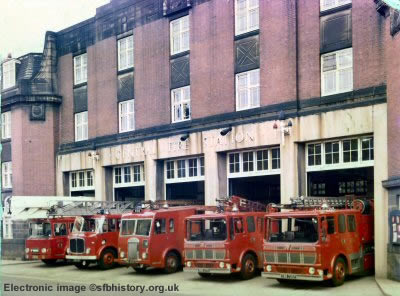 Central Fire Station and Headquarters, Division Street 1968 Photograph courtesy of Dave Lockwood |
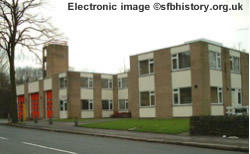 Photo - Ted Mullins |
The building development that had been carried out in the Stannington and South West area of the City, and the consequent increase in traffic congestion made it clear that a new fire station would be required in the Rivelin area , and subsequently the station on Rivelin Valley Road, was opened during the Summer of 1969. |
| During 1968/69 two new appliances were obtained. The first was an 85 ft. Simon Snorkel Hydraulic Platform, one of the few in the country of that size. This appliance could be used for rescuing several people at a time from high buildings, and could also be used to convey Firemen for fire-fighting purposes to the upper floors without using the staircases. |
 Photograph from: Sheffield Fire Brigade - A Brief History |
| The other was a small Emergency Tender obtained in 1969 which carried special rescue and cutting equipment, particularly for use at road accidents. This vehicle was based on the 'Forward Control' Land Rover chassis, and it soon became known as 'The Pig' because of its tendency to go wherever it wanted, and the drivers job was to get it back from wherever it was going. |
 Photograph from: Sheffield Fire Brigade - A Brief History |
Sheffield Fire Brigade - Fire Stations and Premises
In 1969 Sheffield Fire Brigade had 7 fire stations, employed 294 people and had a fleet of 47 vehicles. To view the full details download the 1969 Establishment Sheet.
Note:
The Sheffield Station numbers were as follows:
| Division St | Stn 1 |
| Darnall Rd | Stn 2 |
| Lowedges Rd | Stn 3 (Also the former Norton Fire Station) |
| Mansfield Rd | Stn 4 (Also the former Woodhouse Rd Fire Station) |
| Elm Lane | Stn 5 |
| Mosborough | Stn 6 |
| Rivelin Valley Rd | Stn 7 |
| Ringinglow Rd | Stn 8 |
The Formation of the Metropolitan Fire Brigades
Also, in 1969 the Redcliffe-Maud Report proposed the creation of three large "metropolitan areas" based upon the conurbations surrounding Manchester, Liverpool and Birmingham. Merseyside, and West Midlands, which were to have both metropolitan councils covering the entire areas, and district councils covering parts. Harold Wilson's government published a white paper accepting these recommendations broadly, also adding South Hampshire (including the Isle of Wight) and West Yorkshire as metropolitan areas.
Note: The proposals of the report were radically altered when Edward Heath's Conservative government came to power in 1970. The Conservative's local government White Paper was published in February 1971, naming the metropolitan areas "metropolitan counties", and giving them as "Merseyside, South East Lancashire and North-East Cheshire, the West Midlands, West Yorkshire, South Yorkshire, and the Tyne and Wear area".
The metropolitan counties were finally established by the Local Government Act in 1972, the county councils were first elected in 1973, and these elections would lead to the formal establishment in April 1974. of Greater Manchester, Humberside, Merseyside,South Yorkshire, Tyne and Wear, West Midlands and West Yorkshire as the new metropolitan counties.
The metropolitan county councils (MCCs) were intended to be strategic authorities that ran regional services such as main roads, public transport, emergency services, civil protection, waste disposal, and strategic town and country planning. In 1973 work commenced on the formation of the South Yorkshire Metropolitan Council Fire Service.
Note: Prior to the 1941 there had been 1,400 individual fire brigades, and following the return to local authority control in 1948 this number had been reduced to 134. However, the inception of the inception of the Metropolitan Councils would further reduce the number of individual fire brigades to 49.
Mr G. E. McCoy was appointed CFO SYFS with effect from 21st June 1973 at a salary of £8,669 rising in 3 annual increments of £240 to £9,389.
On the 29th August 1973 the CFO (designate) reported to the newly formed South Yorkshire Fire Service Committee that the resources available to the new service would be:
27 Fire Stations (19 wholetime and 8 retained)
68 Fire appliances (50 water tenders and 18 special appliances)
1053 Members of staff (702 wholetime personnel, 245 retained personnel and 106 non-uniformed employees).
These personnel would become the responsibility of the SYFS on 1st April 1974.
On the 4th October, 1973 the Fire Service Committee considered the title of the new firefighting, fire protection and emergency service. It was recommended that the Service be called “The South Yorkshire Fire Service”.
1971 Sheffield Fire Brigade gets a new Emergency Tender
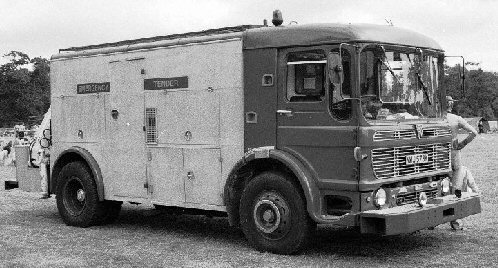 |
Effingham Street Gas Explosion 25th October, 1973
On 25th October 1973 a gasworks explosion killed three men, and injured scores of other people near the centre of Sheffield. Thirty people were taken to hospital and four were detained, but many others had minor cuts and bruises that did not require hospital treatment.
The explosion was in a disused million-gallon petroleum tank in which town gas was once stored below ground level at the East Midland Gas Board works in Effingham Road, Sheffield. The explosion destroyed part of the works ripping off the roof and sending lumps of concrete weighing up to half a ton shooting through the air.
|
|
Two further Fire Stations were completed during the period 1973/74 these were Ringinglow Road and Elm Lane (This was a replacement for a wartime station already on site).
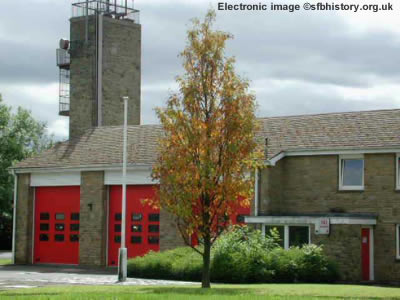 Ringinglow Fire Station |
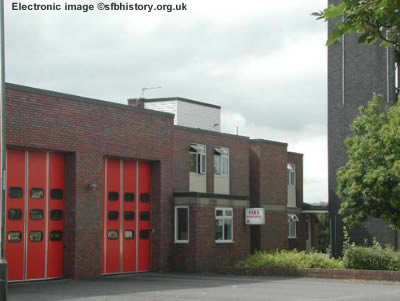 Elm Lane Fire Station |
On the 1st November, 1973 the South Yorkshire Fire Service Committee agreed on the Assistant Chief Fire Officer posts which should be made from the 1st November 1973. The persons appointed were:
| H. Jones (CFO Rotherham County Borough) | SYFS ACO (Deputy CFO) |
| F. Peel (ACO Sheffield Fire Brigade)* | SYFS ACO (Technical) * Designated Third Officer |
| Sibert F. (ACO West Riding County Council) | ACO (Staff) |
| Cooper A. (Acting CFO Barnsley County Borough) | ACO (Fire Prevention) |
At that same meeting, the Committee resolved that their previous resolutions with regard to the title by which the new Brigade was to be known, should be amended to read, 'South Yorkshire County Fire Service' so the word "County" was inserted into the previous title.
0n the 3rd January 1974 the South Yorkshire Fire Service Committee resolved that Mosborough Fire Station would be upgraded from Day-Manning to Wholetime, effective from that 1st April 1975, and it is interesting to note that the personnel at Mosborough at that time submitted a letter to the Chief Fire Officer (designate) making representation against the decision of the Committee to upgrade the Station.
On 7th February 1974 the South Yorkshire Fire Service Committee resolved that the establishment of Firemen, Leading Firemen and Sub Officers in the South Yorkshire County Fire Service should be as follows:‑
| Firemen | 530 |
| Leading Firemen | 130 |
| Sub Officers | 86 |
| TOTAL | 746 |
added to this were 60 posts for residential Officers of Station Officer rank and above. The combined establishment of uniformed and non-uniformed members would now be 1246; this would include some non-residential officers of Station Officer rank who would be serving on the Divisional Stations.
The above indicates some of the background committee work that was necessary to ensure that from Midnight on 1st April 1974 the new Service would function.
On 25th February 1974 a tragic incident occurred at the British Steel Tinsley Works, Shepcote Lane.
On the afternoon of the 25th February whilst crews from Darnall Road, Mansfield Road and Division Street Fire Stations were attending a fire caused the leakage of molten metal at the British Steel Corporation’s Tinsley Plant of Shepcote Lane. An explosion occurred as fire crews were tackling a flow of molten metal, which was pouring from a soaking pits used to re-heat ingots prior to rolling.
Each pit could take up to 70 tons of steel. There were five ingots, each weighing 12 tons in the pit when the explosion took place, an explosion of such force that it was heard half a mile away by other workers. From all accounts at the time, it appears that the Darnall fire crew took the full force of the blast.
The injured were:
| Detained at the Northern General Hospital Burns Unit: Peter Childe (Fireman) Bob Codman (Fireman) Brian Ellis (Station Officer) Paul Parkin (Fireman) Bob Smith (Sub Officer) |
Treated at the Royal Infirmary and released: Frank Davis (Fireman) Ernest Greaves (BSC Worker) Bob Johnson (Fireman) Peter Knutton (Assistant Divisional Officer) Charles Mason (BSC Worker) Ken Needham (Fireman) David Rosewarne (Fireman) Barry Whittaker (Fireman) |
On the day following the explosion a spokesman for the Northern General Hospital described the condition of Peter Childe, Bob Codman and Brian Ellis as "satisfactory" and the condition of Paul Parkin and Bob Smith as "very poorly". On the 28th February 1974, Bob Smith aged 47, of Cartmell Road, Woodseats, lost his fight for life.
|
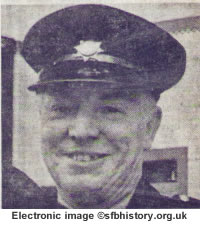 Bob Smith |
Bob Smith
Bob Smith's job was saving other people's lives and property. His proudest possessions were a medal from the Queen, and a commendation for bravery signed by the late Winston Churchill.
But Bob was no stranger to danger. He had known Frank Mallinson, fatally injured in a blast at the Mermaid Cafe in Norfolk Street, Sheffield, in 1968. But Bob was never put off by the risks he took. In 1954 he was lowered to rescue two 15-year-old boys from disused mine workings at Loxley and was nearly overcome by poisonous fumes.
The rescue did not go unnoticed. It earned Bob and his colleagues an award for bravery. His commendation was signed by the then Prime Minister Winston Churchill and Bob I proudly framed it.
12 months ago, one year after receiving his 20-year long service medal, Bob was promoted to sub-officer. It meant moving from Lowedges, where he served as leading fireman, to the busy Darnall station.
Sub-Officer Smith, aged 47, of Cartmell Road, Woodseats, Sheffield, was stationed at Darnall, served in the Sheffield Fire Brigade for 23 years. He leaves a wife and a son, Christopher, aged nine.
Paul Parkin
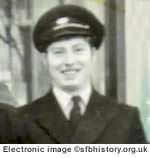 Paul Parkin Photograph courtesy of: Mrs Barbara Ashton |
On the 10th March 1974 the explosion claimed its second victim when Fireman Paul Parkin, of Bramley Drive, Handsworth died in hospital. He was 27. Paul, who left a widow Barbara and two daughters, Marie aged 5 years, and Suzanne aged 3 years, had been fighting for his life in the Northern General Hospital. Barbara was three months pregnant at the time of his death with their third child, Mark Paul who was born in September 1974. |
Fireman Bob Codman and Station Officer Brian Ellis later returned to duty after a long convalescence. However, Firemen Peter Childe, after a short period of light duties at Division Street Fire Station was forced to retire from the service due to the injury to his eyes.
Editors Notes:All the above information has been supplied by Mrs Barbara Ashton, Paul's widow, and I thank both her and her daughter Mrs Marie Burditt, for all their help in compiling this section. If any of the dates are incorrect please let me know and I will correct the mistake immediately. Furthermore, and following representations from Paul's daughter Marie, who considered that because it had been the 40th anniversary in March 2014 of the tragic incident, and the fact that Paul's son Mark was 40 in September 2014, it might be an idea to apply for an award for Mark to receive for his birthday. Following her representations, South Yorkshire Fire and Rescue decided that it was time to honour firemen who died, and to mark each event independently. Consequently, on the 22nd September 2014, at 2.00pm In the Lord Mayor's Parlour at Sheffield Town Hall, the Lord-Lieutenant presented Mark with a posthumous certificate in recognition of his father's service to the public of South Yorkshire.
| Copy of Paul's Certificate | Copy of the Presentation Booklet |
On the 31st March 1974 Chief Fire Officer S. Lambert retired and the City of Sheffield Fire Brigade, Doncaster Metropolitan Borough Fire Brigade, Rotherham Metropolitan Fire Brigade, Barnsley Metropolitan Fire Brigade, and the parts of the former West Riding Fire Brigade that lay with the new South Yorkshire boundary became the South Yorkshire County Fire Service.
Sheffield City Fire Brigade ceased to exist at midnight 31st March 1974, and one unfortunate consequence of this for the men and women of the new county's former city, towns and district fire brigades was that civic pride packed its kit bag and took the last train for coast.
To: All Officers and Men of the Brigade, Civilian Official Staff and all Workpeople. On the 31st March I officially retire and relinquish command of this the City of Sheffield Fire Brigade. May I say a simple but very sincere thank you for the way in which every single member of this Brigade has worked together and has built up over the years an efficient organisation of which I know all of you like myself are justly proud. Looking to re-organisation and the years ahead I hope you will find the rewards and progression you so justly deserve. May they be happy years.
Chief Fire Officer |
Editors Note:
Ex CFO Stanley Lambert died in Hull in September 1985, at the age of 73.
